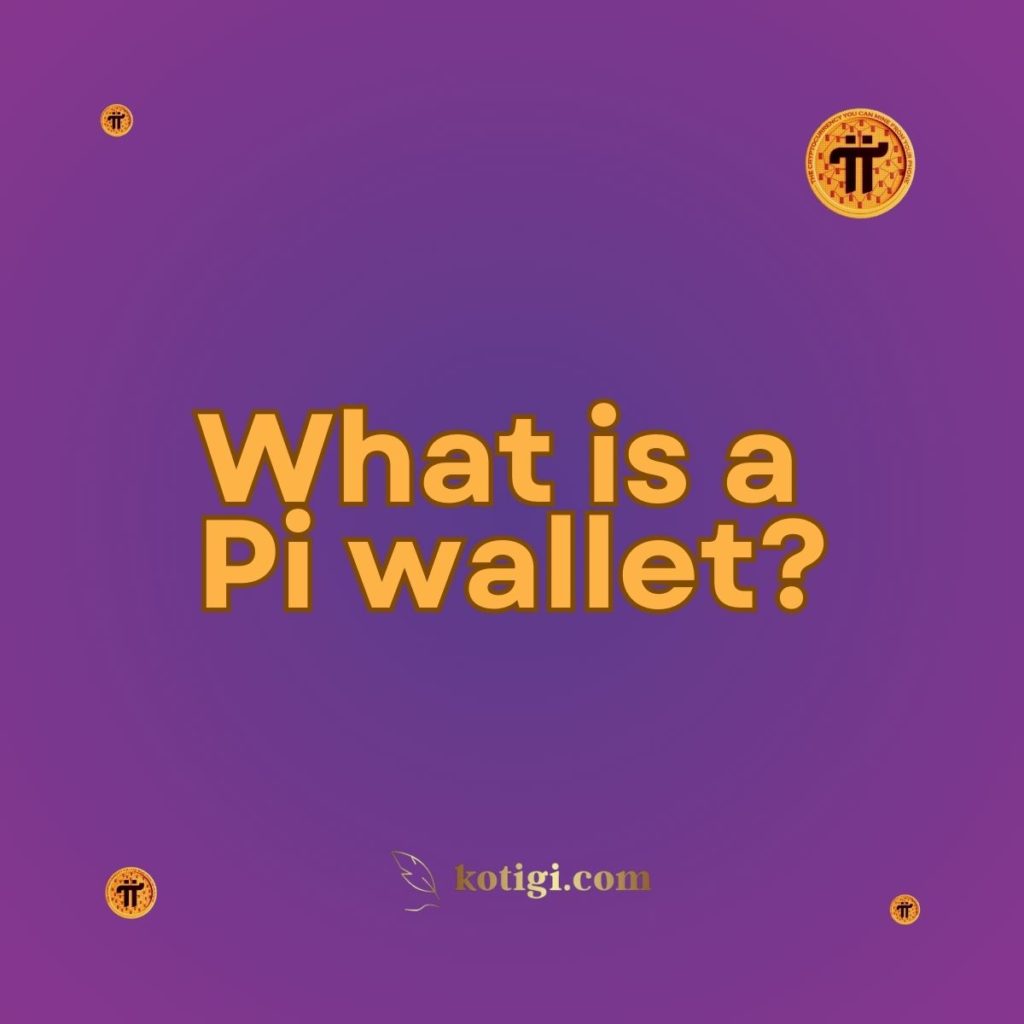
What is a Pi wallet?
A Pi wallet is a digital wallet designed for storing, managing, and transacting Pi tokens within the Pi Network. This post explores the features, functionalities, and importance of the Pi wallet in the broader cryptocurrency ecosystem.
Introduction
In the dynamic world of cryptocurrency, digital wallets serve as essential tools for managing digital assets and facilitating secure transactions. For users of the Pi Network, understanding what a Pi wallet is and how it operates is crucial for effectively handling their Pi tokens. A Pi wallet not only allows users to store their tokens securely but also enables them to engage in various activities within the Pi ecosystem. In this blog post, we will explore the concept of a Pi wallet, its key features, how to use it, and its significance in the broader cryptocurrency landscape.
1. What is a Pi Wallet?
1.1 Definition of a Pi Wallet
A Pi wallet is a specialized digital wallet designed specifically for the Pi Network, enabling users to store and manage their Pi tokens, the native currency of the network. Just like traditional wallets hold physical cash, a Pi wallet serves as a digital repository for Pi tokens, allowing users to send, receive, and securely store their assets. The wallet acts as a critical interface between users and the Pi Network, ensuring that transactions are conducted smoothly and securely.
1.2 Types of Pi Wallets
Pi wallets can be categorized into various types, each offering unique features and functionalities tailored to different user needs. Mobile wallets, for example, are user-friendly applications that can be downloaded on smartphones, providing convenience for everyday transactions. Web wallets, accessible through web browsers, offer a quick way to manage tokens without the need for app installation. Hardware wallets, on the other hand, provide the highest level of security by storing tokens offline, making them less vulnerable to cyber threats. Understanding the different types of wallets available helps users choose the most suitable option for their specific requirements.
2. Features of a Pi Wallet
2.1 Secure Storage
One of the foremost features of a Pi wallet is its ability to provide secure storage for Pi tokens. Wallets employ advanced cryptographic techniques to safeguard private keys, ensuring that only the wallet owner has access to their funds. This robust security is crucial in the cryptocurrency realm, where the risk of theft and hacking is prevalent. By utilizing a Pi wallet, users can rest assured that their tokens are protected against unauthorized access and potential loss.
2.2 Transaction Management
A Pi wallet serves as a powerful tool for managing transactions with ease. Users can effortlessly send and receive Pi tokens, thanks to the intuitive interface that most wallets offer. When sending tokens, users simply enter the recipient’s wallet address, specify the amount they wish to send, and review the transaction details before confirming. This streamlined process minimizes the risk of errors and enhances user experience. Additionally, the wallet maintains a transaction history, allowing users to track their financial activities over time.
2.3 Balance Tracking
Another essential feature of a Pi wallet is balance tracking. Users can monitor their Pi token balance directly through the wallet, providing real-time visibility into the amount they hold. This feature is particularly valuable as it helps users make informed decisions regarding transactions, spending, and participation in the Pi Network. By keeping an eye on their balance, users can strategize their mining and spending activities more effectively.
2.4 Integration with the Pi Network
The Pi wallet is designed to integrate seamlessly with the Pi Network, enabling users to engage in various network activities. Whether it’s participating in team mining, trading tokens, or staking for potential rewards, the wallet serves as a key access point. This integration not only enhances user experience but also supports the growth of the Pi Network by facilitating active participation from its users.
3. How to Use a Pi Wallet
3.1 Setting Up a Pi Wallet
Setting up a Pi wallet is a straightforward process that begins with downloading the official Pi Network app. Users are required to create an account, which typically involves providing some personal information and creating a secure password. During the setup, users may also need to complete verification steps to ensure the security of their account. Once the wallet is set up, users are ready to begin managing their Pi tokens effectively.
3.2 Sending and Receiving Pi Tokens
Using a Pi wallet to send and receive tokens is a user-friendly experience. To send tokens, users enter the recipient’s wallet address, specify the amount of Pi they wish to send, and review the details before finalizing the transaction. For receiving tokens, users can simply share their wallet address with others, allowing for easy transactions. This seamless functionality encourages users to engage in transactions regularly, contributing to the active ecosystem of the Pi Network.
3.3 Monitoring Transactions
A Pi wallet also allows users to keep track of their transaction history, providing a comprehensive overview of all incoming and outgoing transactions. This feature is particularly useful for users who wish to maintain transparency in their financial activities. By reviewing their transaction history, users can gain insights into their spending habits, monitor their rewards, and ensure that all transactions are accurate and legitimate.
4. Importance of a Pi Wallet
4.1 Facilitating Transactions
The Pi wallet plays a critical role in facilitating transactions within the Pi Network. As the network continues to grow, the demand for a reliable and secure method of managing Pi tokens becomes increasingly important. A functional wallet allows users to engage in daily transactions effortlessly, whether they are sending tokens to friends or participating in various network activities. This ease of use promotes broader adoption of the Pi Network and enhances the overall user experience.
4.2 Supporting Network Ecosystem
A well-designed wallet supports the overall ecosystem of the Pi Network by empowering users to engage in a wide range of activities. Beyond mere storage, the wallet enables users to participate in team mining, trading, and other innovative features that may arise as the network evolves. The wallet thus acts as a key enabler for users to maximize their engagement and contribution to the ecosystem, reinforcing the collaborative nature of the Pi Network.
4.3 Enhancing Security
By utilizing a Pi wallet, users can enhance the security of their tokens significantly. The wallet employs robust security measures that protect against theft, loss, and unauthorized access. Given the increasing number of cyber threats in the cryptocurrency space, having a secure wallet is vital for users who wish to protect their assets. By prioritizing security, the Pi Network fosters a sense of trust among its users, encouraging them to participate actively and confidently.
5. Future Developments
5.1 Enhanced Features
As the Pi Network continues to mature, users can expect to see enhancements to the Pi wallet, including new features that improve usability and security. Future updates may incorporate multi-signature options, biometric security, and advanced recovery mechanisms, all aimed at providing users with a more robust and flexible wallet experience. These enhancements will ensure that users can manage their assets securely and efficiently.
5.2 Potential for Expansion
The Pi wallet may evolve to include additional functionalities beyond simple storage and transaction management. Future developments could introduce support for other cryptocurrencies, enabling users to manage a diverse portfolio within a single wallet. Furthermore, integration with decentralized applications (dApps) may allow users to participate in a broader range of activities, from trading to staking and lending, enhancing the overall value of the wallet.
5.3 Community Feedback
The Pi Network team values community feedback as a means of improving wallet functionality. Users are encouraged to share their experiences, suggestions, and concerns regarding the wallet’s features and usability. This feedback loop will contribute to the ongoing development of the wallet, ensuring that it meets the needs of its users and adapts to the evolving cryptocurrency landscape.
Conclusion
A Pi wallet is an essential component of the Pi Network, providing users with a secure and user-friendly method for managing and transacting their Pi tokens. With features such as secure storage, transaction management, and seamless integration with the network, the Pi wallet plays a vital role in facilitating user participation and supporting the ecosystem. As the Pi Network continues to develop, the Pi wallet is expected to adapt and enhance its functionalities, ensuring that users have the necessary tools to navigate the exciting world of cryptocurrency effectively.
Key Takeaways
| Key Factors | Description |
|---|---|
| Definition | A digital wallet for storing and managing Pi tokens. |
| Types | Includes mobile wallets, web wallets, and hardware wallets. |
| Secure Storage | Protects private keys and ensures secure access to tokens. |
| Transaction Management | Allows users to send, receive, and track transactions. |
| Integration | Seamlessly connects with the Pi Network for various activities. |
| Future Enhancements | Expected to include new features and expanded functionality. |
| Community Involvement | User feedback plays a role in improving wallet features and usability. |





